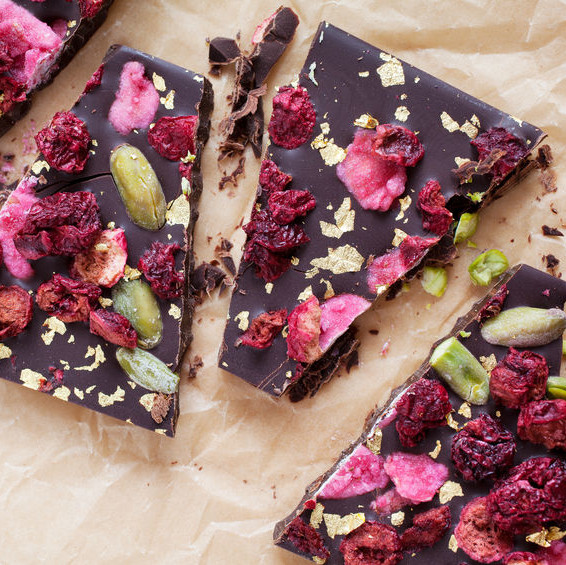
Inclusions
What are Inclusions?
Inclusions are small variegates added to foods and bakery formulations to impart unique textures, flavors, colors or other desirable properties. They are available as slices, flakes, nuggets, pellets or other forms.
Examples of inclusions include:
- Dried fruit pieces
- Chocolate and confectionery chunks
- Unique grains and seeds
- Crunchy nuts
- Flavor or color nuggets and flakes
Function
Inclusions are added to baked goods for a number of reasons. They can enhance texture (nuts, candy, dried fruits), improve the aesthetics and sensory properties (spices, sparkle and glitter flakes) or add indulgence (chocolate chunks, macadamia nuts).
They also can increase the nutritional value. Inclusions can deliver high concentrations of proteins, fiber, vitamins, essential fatty acids, etc. Chia seed and tree nuts for example, are popular inclusions in bakery, they impart unique textures and are a good source of omega-3 fatty acids, fiber and antioxidants.
Inclusions can provide a perception of healthier products (using dried fruits pieces can be used as a replacement for added sugars) or provide product differentiation (targeting specific demographics).
How they are made?
- Natural inclusions: fruits, nuts, chocolates, seeds which can be used as such or cut into various shapes and sizes.
- Processed inclusions: are more complex and can be made by mixing or coating an ingredient (color, flavor or health ingredient) with gums or other food polymers to form a desired shape such as chunks, pellets or nuggets. Most commonly used polymers include starches, celluloses, gum Arabic, alginates, etc. For better protection from high processing temperatures, hydroxypropylmethyl cellulose can be a good option. Coating pellets or flavor/color nuggets with fats with adequate melting points can provide a timed-release of the flavor/color during, right after baking or just before consumption.
Application
Various types of inclusions can be used with bakery products such as breads, cakes, muffins, cookies, biscuits, bagels, sweet rolls and others.
Inclusions are typically incorporated after the dough/batter has been properly mixed. Adding inclusions or variegates may increase the final price of the baked product. Bakers should take into consideration potential issues related to formulation, processing, and quality.
Formulation factors
Ideal inclusions should:
- Not disturb the dough/batter system (e.g. avoid drastic changes to dough/batter density, viscosity, hydration or interfering with yeast activity).
- Complement the base formula or other inclusions that may be added (e.g. using macadamia inclusions for indulgent products).
- Be stable against oxidation, dissolution, color bleeding or migration. Dried fruits such as cranberries are favored for their robustness (minimal color bleeding or degradation) and adaptability to bakery processing.
- Dried fruits with low water activity (aw 0.4-0.6) are normally treated with glycerin to inhibit moisture exchange with doughs and batters which can have detrimental effects on their stability.
- Inclusions such as dried plums may require adjusting the cake batter’s leavening system. This is a result of the plums high phosphate content which may disturb the acid-base balance in the cake leavening system.
- Nuts are often coated with a thin starch film to protect it against oxidation and reducing the piece density so they will not sink into the bottom of the baking mold.
- Keep incompatible ingredients separate (important consideration for inclusions containing fats different from those of the cake batter system. Migration of fats may result in softening or hardening the texture of the inclusion piece).
- Enhance flavor impact of the baked system (e.g. light toasting of walnuts and almonds inclusions can impart an intense flavor).
Operational factors
Adding inclusions to a bakery formula may require making adjustments to the baking process to:
- Keep piece integrity (for example pre-cut refrigerated cookie doughs containing large chunks of chocolate or other inclusions require specially-designed cutting systems such as ultrasonic wire-cutting systems to avoid creating uneven surfaces or fluctuations in piece weight if using conventional wire-cutting machines).1
- Maintain inclusion pieces such as nuts well dispersed in the dough/batter and avoid their floating to the top or sinking to the bottom.
- Ensure flavor retention and color stability.
- Avoid tearing bread dough or package.
Quality factors
- Fresh fruits if used must be adequately sanitized and handled
- Properly label tree nut-containing products (potential allergens)
FDA regulations
Although glitter inclusions are for the most part safe to consume, the FDA has issued warnings to consumers to ensure that glitter is made from food grade materials.2
References
- Vangeepuram, S., Mihaelos, N. and Janulis, T.N. 2016. Production of cookies having large particulates using ultrasonic wirecutting. U.S. Patent 9,339,041 B2 (to Kraft Foods Global Brands, LLC).
- FDA.To Eat or Not to Eat: Decorative Products on Foods Can Be Unsafe December 14, 2018. https://www.fda.gov/ForConsumers/ConsumerUpdates/ucm628260.htm

